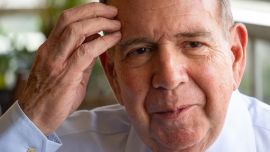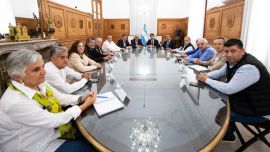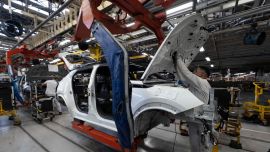This October didn’t only mark a seasonal transition in Latin America. Winds of change have gripped the entire region — most notably in Chile, Ecuador, Bolivia and Peru —and thrown it into turmoil. Thousands hit the streets, using the ballot box, mass demonstrations and, in some cases, violent protests to speak out against alleged government corruption, rising social inequality and cuts in social spending.
Chile, whose economic approach has long been touted by policy experts as exemplary, continues to endure its worst violence in decades, with protests now dragging into a second week. A transit fare hike was the tipping point, spurring nationwide protests against inequality. Though many protests have been peaceful, others have looted or burned everything from shops and subways to government offices. The human toll has mounted rapidly: 19 dead, over 200 injured and thousands jailed.
President Sebastián Piñera’s decision to declare a state of emergency last Saturday was not even the first time this month a Latin American leader had done so.
In Quito, President Lenín Moreno faced a similar powder keg moment when International Monetary Fund-backed austerity measures and a rise in fuel prices sparked violence. He ordered Ecuador’s military to patrol the streets. Peru also experienced political drama when President Martín Vizcarra and his legislative counterpart became embroiled in conflict over corruption.
Elections in Bolivia last weekend ended in disarray. Some allege the resource-rich Andean country’s president, Evo Morales, fixed the results, a theory bolstered when outstanding votes were withheld for almost 15 hours once numbers hinted the incumbent may face a run-off. Opposition supporters took to the streets, leaving destruction in their wake. As of Friday night, with 100 percent of the preliminary count completed, Morales had taken 46.64 percent of the vote compared to 36.83 percent for former president Carlos Mesa.
Even Uruguay, Argentina’s normally-tranqui neighbour, witnessed 55,000 people march peacefully through Montevideo against a proposed security reform Tuesday night. The ballot measure, which voters will decide on during Sunday’s elections, would create a joint military-police law enforcement coalition to address rising crime, permit more night searches and harshen certain prison sentences. Some opponents of the tough-on-crime measure have argued that empowering the military in this way violates the Constitution.
Argentina, meanwhile, is braced for economic turbulence in the wake of Sunday’s election. Voters condemned President Mauricio Macri’s budgetcutting agenda with a resounding defeat in August’s PASO primaries. Alberto Fernández and his running mate, former president Cristina Fernández de Kircher won by an astonishing 16 points, scaring investors and pushing the Frente de Todos hopeful firmly into pole position.
CAUSE FOR UNREST
The question of how, or even if, these events tie together in some way remains unclear. Are these movements coincidentally timed events, bubbling over from idiosyncratic frustrations in each country? Or are they emblematic of a larger grievance sweeping the region, one that foreshadows a broader challenge to the status quo?
On the surface, few things unite these nations other than geography. Chile is wealthy. Ecuador suffers from poverty. Bolivia’s government calls itself socialist. Peru calls itself moderate.
“We’re talking about unrest that straddles poor countries and wealthier countries, left and right, democracies and authoritarian governments,” said Ivan Briscoe, Latin America Director for the International Crisis Group. “That makes a single explanation incredibly hard to achieve.”
Though that hasn’t kept a number of government officials in Argentina from trying.
President Mauricio Macri’s running-mate Miguel Ángel Pichetto, Foreign Minister Jorge Faurie and Security Minister Patricia Bullrich, each voiced strongly-worded opinions alleging recent events are not random, but rather the symptom of a strategic alliance between Venezuela and Cuba that seeks to “destabilise” the region.
“They intend to intervene in the political, institutional and social lives of our countries,” Faurie said. “They threaten us like a Bolivarian hurricane bringing hunger, poverty, dictatorship, the loss of liberty and a prison sentence.”
Briscoe called this theory “absolute nonsense.”
“The Venezuelan government is cash-strapped, weakened, and focused on survival. It is not exporting revolution,” he told the Times.
In fact, these various conflicts have emerged as a result of distinct circumstances in each country, said Benjamin Gedan, director of the Argentina Project at the Wilson Center in Washington DC. But there AFP / MARTIN BERNETTI are certain themes that are present throughout.
DISSATISFACTION DUET
Experts point to the “duet” of economic and political dissatisfaction animating those unable to maintain their way of life or climb the socioeconomic ladder since the end of the commodities boom around 2013, during which Latin America enjoyed a significant, albeit fragile, period of economic enrichment.
A famous 2012 World Bank report determined over 50 million people moved into Latin America’s middle class during this period. They weren’t buying homes or cars, Briscoe said, but they were lifted out of poverty and saw a relative improvement in quality of life. That sizeable group is now ripe for dissent should it be unable to access these changes, however precariously achieved.
“Economic growth has slowed, limiting opportunities and constraining the capacity of governments to sustain social spending,” said Gedan. “Polls have shown steep declines in support for democracy [...and] growing frustration with public corruption.”
A study from Latinobarómetro, a Chilean think-tank, revealed just 30 percent of people across Latin America trust their democracy. In Argentina, 82 percent of people are dissatisfied with the direction of the country, and only 20 percent believe elected officials act in the electorate’s interest, according to data from the Pew Research Center.
Another element broadly uniting these wider conflicts is social media, which allows opposition to criticise governments quickly and more effectively, Gedan added.
There’s a persistent backdrop of economic frustration and estrangement from political institutions in Latin America that’s exacerbated the way social media push people toward the extremes, said Briscoe. “It provides a means of campaigning and mobilisation that generally leads to the exclusion and denigration of opponents in a way that other debate doesn’t,” he added.
The result? An alarmingly high level of political polarisation that puts the strength and efficacy of existing institutions in Latin America at risk.
Such bodies weaker than they have been in decades, according to Briscoe, citing his overarching worry that should a real armed conflict ever break out in the region, there’d be no way to pilot a solution.
“If there’s an explosion of violence somewhere or significant degradation in any of the countries affected by civil unrest, all against this background of divided rhetoric whereby groups believe they’re fighting for survival, who is going to bring that armed conflict to an end?”
related news

Time for 'democratic transition' in Venezuela, says opposition candidate Edmundo González Urrutia

Mercosur free-trade deal is ‘absolute priority’ for the EU, says chief negotiator

Stories that caught our eye: April 12 to 19



















Comments